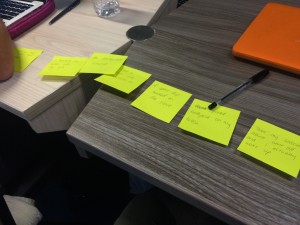The final lectorial of the semester I was absent for due to being swamped in other assignments and therefore, I searched on the media one on media factory to observe what they discussed and it seems as though the discussed the topic “media materialism”. Discussing the natural evolution of medium theory, and I assume he is discussing the topic of technology and how our society has evolved with this as our main resource in our lifestyle.
Category Archives: Lecotorial reflections
Media 1, Week 11 Lectorial Reflection
This week they discussed the topic of remixes, and the controversy with copyright. It’s a difficult argument as although they are creating what may be considered “new” music, they are using works of other artists that have already been created to do so. It’s like someone has put all the effort into creating a song with lyrics and a beat, and someone has taken it and “upgraded” it, and the original may not be left with as credibility. However, a remix could actually enhance the popularity of a song, putting it out further into the commercial music industry world. It’s all about the ethics and morality that undergo when an artists wants to remix another artist’s work, and those who are ignorant to these morals are the ones that keep this debate still running.
Media 1, Week 10 Lectorial Reflection
This week’s lectorial was based on one of the themes for the Project Brief 4, ‘institutions’. As a class we listed instituations down on the board, however I did not expect them to be listed as they were. When I thought of institutions I imagined buildings, and programs. Although, our class started listing other things such as values, superstitions, which opened up a new world of “institutions”, we started to analyse them more as classifications:
– historialcal continuities
– rituals, symbolic
– values
– expectations
– superstitions
-legal fraemwork/regulatory
-widley accepted
We then discussed media institutions, and here is a list below of what was mentioned:
ABC, the news, journalism, newscorp, cinema, broadcast television, community radio, public service broadcasting.
Media 1, Week 9 Lectorial Reflection
For this Lectorial, Brian spoke on the topic of audiences. There is a wide range and variety amongst audiences, each particular program/show/book/entertainment/retail have a specific target audience in which they may approach. Audiences are extremley important, as without them there would be no proof of success for a specific artefact. Those who consider audiences very important are:
Advertisers, Commercial broadcasters, cable networks etc, Production houses and individual program makers, Government policy makers, Social scientist/psychologists, and Cultural theorists/media scholars.
To accompany this lecture, we watched 2 separate artefacts. The first was Robert Menzies “welcome to television” presentation in 1956, followed by a scene from the tv show “Portlandia”.
Media 1, Week 8 Lectorial Reflection
Today we had Dan speaking on the subject of narratives. He spoke what was considered a narrative and what might not be and how they are used in the media industry to express meanings and stories to viewers. We begun by doing a simple in-class task where we would discuss and note on the emotional highs and lows on a narrative for a particular film. Our group chose Hunger Games:
|
The Hunger Games |
||
| Emotional Highs | Emotional Lows | Characters in order of prominence |
| Katniss wins the Hunger Games with Peeta | Prime gets choosen in the reeping | 1. Katniss Everdeen |
| Peeta kisses her | Rue dies | 2. Peeta Mellark |
| Katniss kisses Peeta | Peeta joins Katniss’ enemies | 3. Rue |
| Peeta gives Katniss bread | Katniss catches on fire | 4. Haymitch |
| Sponsors provide Katniss medicine | Katniss enters the games | 5. President Snow |
| Katniss says goodbye to her family | 6. Seneca Crane | |
| Katniss says goodbye to Gale | 7. Gale Hawthorn | |
| Katniss is going to commit suicide with the berries | 8. Effie Trincket | |
| 9. Primrose Everdeen | ||
| 10. Mrs. Everdeen | ||
We then watched these short films called “rebirth”. There were no talking, just a small amount of text and footage and sound. The main question was, is this considered a narrative? I believe yes, and this is because the small texts of word added context to the film. These short films starred individuals who were “rebirthing” themselves, for example, one male jumped through a window, another jumped above 2 cars in a head-on crash.
Finally, we concluded with another in-class activity to understand why it is considered a narrative and why it is not:
Non-narrative:
no main story line
no speaking
Narrative:
text
sound
artistic
suicide
Media 1, Week 7 Lectorial Reflection
During today’s lectorial, Daniel Binns elaborated on one of the subjects for the Project Brief 4, Texts. Texts “are the material traces that are left of the practice of sense making – the only empirical evidence we have of how other people make sense of the world”. Its interesting to think that texts are a form of communication in which help share and view the production of ideas from one generation to the other. Text has been around for ages and allow for many fictional and non fictional stories to continue to live on. It’s used in almost every medium of media, magazines, books, movies, online, and more, it allows for titles or an extended elaboration to express feelings, stories, and information from one individual to another.
Media 1, Week 6 Lectorial Reflection
The beginning of the lesson was based on understanding how to use the Library Search for RMIT, yes, it is true, this is the third time I’ve had to sit through this lecture, and no, it was still all the same. Nonetheless, I understand why they do it, once I figured out how to use library search finding academic resources became a lot easier. From then we did a small in-class task and we did a pros and cons list for Google which you can see below I attained 100% #genius

After this, Rachel spoke to us about the importance of collaboration and team work when working in group assignments. It’s important to be innovative, consistent, punctual and respectful, as team work is everything in the workforce of the media industry. Rarely anyone works alone, and so it’s important to understand and learn how to work appropriately and successfully within groups, which I completely agree with.
Media 1, Week 5 Lectorial Reflection
Still too unwell to attend uni, I missed out on this week’s lectorial. However, reading over the notes that were posted on the Media 1 Blog, it seems as though Project Brief 3 has already been introduced, which will incorporate a mix of both original and found footage. Further notes were made on how to annotate and appropriately skim-read through readings which I found very useful. All my subjects provide useful readings to annotate, however it becomes overwhelming when I have 3 subjects providing 2 readings that are both 100 pages long. Hopefully I can use this to help get through the readings faster without missing any important information.
Media 1, Week 4 Lectorial Reflection
During today’s lectorial, we had an in-class activity which incorporated sticky notes and story telling. With my partner, we created an introduction scene, an ending scene, and 3 middle scenes in which could be put into any order. I didn’t quite understand the purpose of the activity, nonetheless we had some pretty random sticky notes all over our desks.
We then had 2 guests, Adrian Miles and Liam Ward. Both speakers spoke about the studio of documentary studies and filming. Adrian Miles focused on the idea of our high crafting skills coming from a “deep tacit of knowledge of your stuff” whereas, Liam Ward spoke more about the magic of editing and other effects used in filming documentaries.
Media 1, Week 3 Lectorial Reflection (c)
The Media 1 students were lucky enough to have 3 guest speakers during today’s lecture. One of the presenters was Anne Lennox, a Senior Coordinator in Copyright Management. We were exposed to the importance of legal and moral rights of Copyright that is implemented within Australia. I was intrigued to find that copyright is automatically implemented once something is created, I admire how Australia respects the right of intellectual property of an artist in today’s society. The creative industry is so huge, it’s pleasant to understand that majority of original artworks and ideas are aimed to be protected, and not just for the duration of an artist’s life but for another 70 years after their death.
